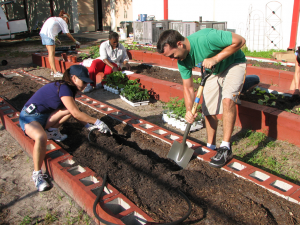This is the second blog post in a series on diversity, equity and inclusion in Colorado agricultural water planning. Find the first post here.
As discussed in our previous post, Colorado has an exciting opportunity to create a truly sustainable future for residents by making its water plan update process more inclusive. There are at least three groups that have been historically excluded from Colorado statewide agricultural water planning: the Colorado Ute tribes, those who operate under acequia management systems, and urban agriculture producers. While these groups have been included at an interstate level and at the local level through the Basin Roundtables, intrastate coordination and statewide inclusion of these folks is in need of improvement.
The 2015 Colorado Water Plan (CWP) acknowledges federally recognized tribes within Colorado and their federally reserved water rights, these important topics are only covered at a high level without in-depth examination of more local nuances. Additionally, the term acequia is mentioned only once in the entire 2015 CWP, in a footnote of a farmer profile.
Colorado should thoughtfully integrate more explicit inclusion for these groups not only in the Colorado Water Plan 2022 update, but also within the Interbasin Compact Committee, the Colorado Water Congress, and the Colorado Water Conservation Board (CWCB). The CWCB has made efforts to initiate more inclusion in the CWP update process through the newly announced Equity Committee. This Committee will constitute two representatives from each of the nine river basins, plus one representative from each of the two Colorado Ute tribes. The true purposes and outcomes from this committee, however, remain to be seen. To create a more thoughtful and equitable Colorado water planning process, the equity committee must focus on creating robust measures for water justice in each element of the Colorado Water Plan Update.
This post will focus particularly on agricultural stakeholders who have been excluded from Colorado water planning. The following sections will provide background and discussion for the three groups identified. While these groups are related in that they were not adequately included in the 2015 CWP, each community is quite distinct. Both acequia water management systems and tribal water users have a rich history in Colorado that must not be ignored in planning discussions. Separately, urban agriculture, while not entirely novel, is a rapidly emerging practice in Colorado’s cities and may serve as an important tool not only to preserve agricultural viability but also to facilitate water stewardship and education. These three communities each have uniquely valuable and important perspectives on regional water issues in the state and should be given specific consideration in the planning process.
Acequias in Colorado
For communities in Colorado and northern New Mexico, an acequia is a physical system, an irrigation ditch, but it is also a deeply embedded philosophy of community and governance. The philosophy revolves around loyalty to the community and a common understanding that water is both a shared resource and a shared responsibility. This ideology has shaped relationships between humans and the environment for centuries in Colorado, creating a resilient natural and cultural system that supports families, communities, and the food system.
Acequia water management systems have been largely excluded in Colorado’s state water planning process, despite the fact that there are thousands of acres of acequias between Colorado’s Rio Grande and Arkansas River Basins. Among the Statewide Water Supply Initiatives, the 2015 Colorado Water Plan, the 2017 Technical Update, and the 2019 Ripple Effects Report, the word acequia is mentioned only once一in a footnote in the 2015 Plan. Acequias are briefly discussed in the 2015 Rio Grande Basin Implementation Plan, and they are not mentioned in the 2015 Arkansas Basin Implementation Plan.
Acequia stakeholders are often absent from statewide planning process meetings and forums. The newly established Colorado Water Equity Task Force does not include any representation for acequia stakeholders. Excluding acequias from the Colorado water planning process shuns an entire population of Coloradans一primarily farmers of color一from statewide water planning and funding. Farmers and others who operate under acequia management must be recognized and included in the statewide planning process for the 2022 CWP update.
Colorado water planners may look to acequia management in New Mexico to model pathways for inclusion. Despite the similarities in culture and natural resource demands in the San Luis Valley, Colorado’s and New Mexico’s governance approaches to acequias are starkly different. Acequia recognition has been written into New Mexico law since the mid-19th century. Furthermore, throughout New Mexico’s statewide water plan, almost every time that agriculture or irrigation is discussed, so are acequias. For example, as mentioned above, the culture of shared scarcity that underlies acequias is crucial to farmers in times of drought. New Mexico’s Water Plan explicitly acknowledges this strength, illustrating that this type of water sharing should be encouraged to support holistic agricultural viability. Colorado water planning could benefit from a similar outlook on the resilience of acequias.
Though the 2009 Colorado Acequia Recognition Statute codified that acequias hold unique powers and rights under Colorado water law, the statute only allows acequias with written bylaws to have the special powers and unique rights recognized under Colorado law. This can be a barrier for acequia communities, as some producers may not have the means to hire a lawyer to draft legally acceptable bylaws. New Mexico’s Water Plan also discusses how the state supports acequia bylaw creation. Such programs are absent in Colorado, where acequia users rely on non-governmental organizations and academic institutions, such as the Getches-Wilkinson Center Acequia Assistance Project and the Sangre de Cristo Acequia Association, rather than on funds directly from the state.
Colorado water planners should consult with stakeholders within Colorado’s acequia communities on how to best include planning and funding for acequias in statewide water management. Historically, the relationship between acequia managers in the San Luis Valley and in the Arkansas Basin with the Colorado Water Conservation Board has not been the strongest. CWCB should be inclined to add another seat to the equity committee specifically for acequia representation to try to remedy this historic exclusion.
Colorado Ute Tribes
The Ute peoples are the oldest continuous inhabitants of the land now called Colorado. They have been intimately tied to the waters of the region for many centuries, long before incursion by European colonizers and settlers. However, beginning in the mid-19th century, the United States federal and Colorado state governments began systematically dispossessing the Ute people of their land and separating them from their sources of water.
By the end of the 19th century, the only three bands of Ute peoples remaining in the state had been relegated to its southwest corner, in what are now the Southern Ute Indian and Ute Mountain Ute reservations. Although the Ute people had been gradually pressured to adopt a settled agricultural lifestyle, they were removed to some of the least suitable lands for agriculture in the state.
Despite these setbacks, both tribes have fostered successful agricultural communities on their reservations; the Ute Mountain Ute Tribe’s Farm and Ranch Enterprise, for instance, has been repeatedly recognized at both state and national levels for its products.
Much has been done in the last 30 years to address some of the historical inequities created by the separation of the Colorado Ute Tribes from their ancestral lands and traditional water sources. The 1988 Colorado Ute Indian Water Rights Settlement Act and subsequent 2000 Amendments clarified and quantified the Tribes’ reserved rights and authorized a reduced Animas-La Plata Project as well as deliveries from McPhee Reservoir to provide a reliable source of water to the tribes. Both tribes are active members of the Southwest Basin Roundtable and are represented on the Colorado Water Equity Task Force, and the importance of Tribal reserved rights is addressed in the 2015 Water Plan.
Both tribes, however, still face significant supply and infrastructure challenges, as detailed in the 2018 Colorado River Basin Ten Tribes Partnership Tribal Water Study. Some of these infrastructure projects, such as the Pine River Indian Irrigation Project, are nominally maintained by the federal Bureau of Indian Affairs, although that agency’s budget and staffing challenges make adequate upkeep difficult.
As holders of federal reserved water rights, the Southern Ute Indian and the Ute Mountain Ute tribes are invaluable partners to the State of Colorado and the Southwest Basin in addressing water management challenges, particularly issues of interstate compact compliance. Much of the groundwork for this partnership has been laid in the Ten Tribes Partnership Study, which provides detailed data on the challenges faced by the Colorado Ute Tribes, as well as opportunities that working closely with the tribes can provide state and regional water planners. The study provides an excellent starting point for addressing the challenges faced by the tribes and highlights their importance in addressing the water challenges faced by the State and the region.
Given the challenges and opportunities posed by the tribes’ unique water rights and the long history of oppression and exclusion of Indigenous peoples by both the federal and state governments, particular considerations of equity and justice must be extended to the Colorado Ute Tribes in regards to water issues. This is particularly important because tribes’ vital cultural, spiritual, and ceremonial uses are often not adequately addressed in Western legal and economic structures.
Careful, intentional, and respectful consultation with the tribes一as well as inclusion in statewide deliberative water planning processes一is essential to developing a robust understanding of their needs, as well as the cultural significance and intended uses of water.
Urban Agriculture
 Urban agriculture (UA) is most simply defined as “all forms of agricultural production occurring within or around cities.” In any given urban area, this may include quite a variety of operations and projects, including ground-based outdoor gardens and farms, indoor hydroponic or aquaponic growing, rooftop gardens and farms, landscaping and nurseries, urban livestock, and more. The sector is growing as cities become home to more UA-focused organizations, citizens get more creative with urban landscapes, and policies incentivize green infrastructure. Such programs or policies are often intended to promote public health, economic development, and enhance socio-ecological relationships.
Urban agriculture (UA) is most simply defined as “all forms of agricultural production occurring within or around cities.” In any given urban area, this may include quite a variety of operations and projects, including ground-based outdoor gardens and farms, indoor hydroponic or aquaponic growing, rooftop gardens and farms, landscaping and nurseries, urban livestock, and more. The sector is growing as cities become home to more UA-focused organizations, citizens get more creative with urban landscapes, and policies incentivize green infrastructure. Such programs or policies are often intended to promote public health, economic development, and enhance socio-ecological relationships.
Over time, UA has taken on a new form and meaning. With connections now to social justice and environmental sustainability, urban farming has taken root in countless large and small city centers across the nation, oftentimes appearing in the form of community gardens, rooftop gardens, and greenhouses. UA is not recognized in the Colorado Water Plan, or many other western state water plans, despite its growing popularity across the nation. UA offers a multitude of exciting opportunities to foster resilience within western water planning and our food systems.
Regardless of the form it takes, all UA operations require water. Water resources may be utilized on a wide spectrum of UA irrigation tactics一from traditional flood irrigation in peri-urban fields to precision application in a vertical farm. The increasing prevalence of UA operations in Colorado cities requires more attention from water planners, especially as food production technology advances and local food becomes more popular among citizens. The CWP update should not only provide support for both existing operations, but also recognize the potential water-efficient food production in the future of UA. This will be especially important as Colorado could see a shifting food system in the face of climate change and urbanization. The current trajectory of UA could provide a significant contribution to water resilience planning and food production for Colorado.
Though this growth may represent an exciting shift in the food system, it is crucial to recognize UA’s capacity for exacerbating environmental injustices. Often, initiatives led by non-residents may be detrimental to local communities. This is especially prevalent when mostly young, white non-residents have led initiatives in predominantly Black and/or Latinx neighborhoods, “unintentionally excluding people of color from participating in or reaping the benefits of such efforts.” Furthermore, residents of lower-income communities and/or people of color are more likely to experience difficulty accessing land, funding, and political support for UA projects than white and middle class individuals or organizations. Therefore, in order to avoid perpetuating injustice, UA implementation must be nuanced and place-based. A successful and anti-racist CWP update will recognize possible inequities and provide support for urban residents to facilitate UA projects within their own neighborhoods.
This overview intends to provide the background and ethics necessary to integrate the Colorado Ute Tribes, acequias, and urban agriculture considerations into the Colorado Water Plan update. In an effort to begin the process of elevating voices of underrepresented communities, this research team hosted a virtual listening session and working meeting for water planning professionals and UA stakeholders. This event was meant to serve as a platform for stakeholder and administrator collaboration with the goal of creating a more equitable and inclusive CWP update. Our next post will detail the process and results of this meeting.
 Willow Cozzens currently serves as the Water and Equity Project Coordinator for the National Young Farmers Coalition and Frontline Farming and as the Equity and Food Policy Analyst for Jefferson County Department of Public Health. She holds a Master’s degree in Sustainable Food Systems from the University of Colorado – Boulder, where her coursework and practical application projects were focused in environmental policy, food and agriculture law, natural resources science, and responsive activism. Willow is particularly passionate about the cultural and economic impacts of natural resources management and food justice.
Willow Cozzens currently serves as the Water and Equity Project Coordinator for the National Young Farmers Coalition and Frontline Farming and as the Equity and Food Policy Analyst for Jefferson County Department of Public Health. She holds a Master’s degree in Sustainable Food Systems from the University of Colorado – Boulder, where her coursework and practical application projects were focused in environmental policy, food and agriculture law, natural resources science, and responsive activism. Willow is particularly passionate about the cultural and economic impacts of natural resources management and food justice.
 Samantha Grant just achieved her Master’s degree in Sustainability Planning and Management from the University of Colorado – Boulder. Her graduate work primarily focused on environmental policy, water resource management, and climate justice. Her career interests are largely centered around community-based climate action planning as a means to create inclusive and impactful change for all.
Samantha Grant just achieved her Master’s degree in Sustainability Planning and Management from the University of Colorado – Boulder. Her graduate work primarily focused on environmental policy, water resource management, and climate justice. Her career interests are largely centered around community-based climate action planning as a means to create inclusive and impactful change for all.
 Amelia Nill is originally from Kansas City, Missouri and is a recent graduate of the Master’s of the Environment program at the University of Colorado – Boulder. There, she specialized in Sustainability Planning and Management as well as Water Engineering and Management. She is currently volunteering for the American Water Works Association on their Sustainability Committee. She is interested in pursuing a career in natural resource (specifically water) planning, sustainability and environmental justice.
Amelia Nill is originally from Kansas City, Missouri and is a recent graduate of the Master’s of the Environment program at the University of Colorado – Boulder. There, she specialized in Sustainability Planning and Management as well as Water Engineering and Management. She is currently volunteering for the American Water Works Association on their Sustainability Committee. She is interested in pursuing a career in natural resource (specifically water) planning, sustainability and environmental justice.
 Andrew Primo recently graduated from the University of Colorado – Boulder with his Master’s in Environmental and Natural Resource Policy. His graduate work focused on Western water planning and policy, public lands decision-making, and science-policy communication. His career interests are focused on environmental and science education and outreach, bridging the science-policy gap, and environmental storytelling.
Andrew Primo recently graduated from the University of Colorado – Boulder with his Master’s in Environmental and Natural Resource Policy. His graduate work focused on Western water planning and policy, public lands decision-making, and science-policy communication. His career interests are focused on environmental and science education and outreach, bridging the science-policy gap, and environmental storytelling.


 Print
Print